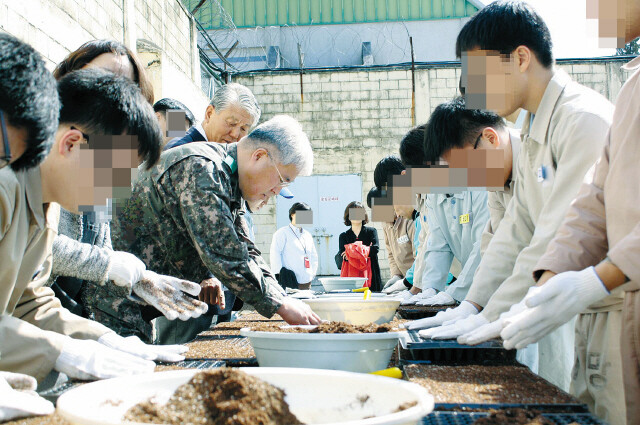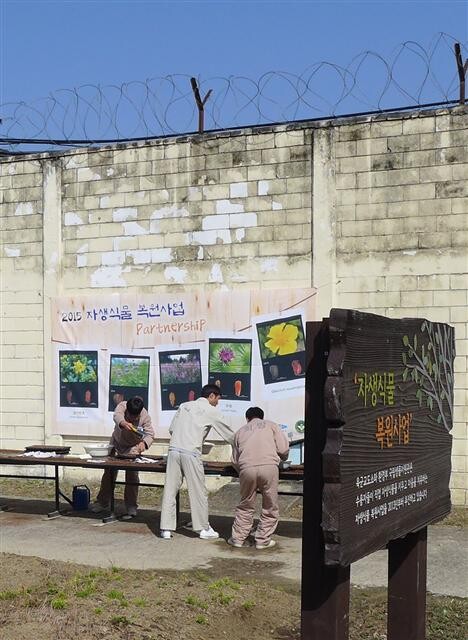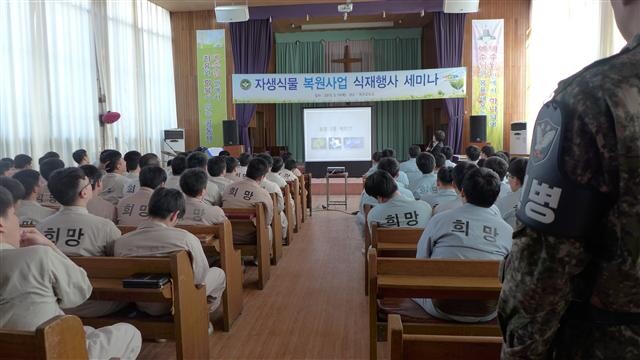hankyoreh
Links to other country sites 다른 나라 사이트 링크
[Reportage] Rare plants bloom in the sun that shines between a prison’s bars

“Hope,” read the word in thick Gothic script on the back of the yellow uniform of the prisoner filling the nursery box with soil for a seedbed. The fireweed seeds in the small plastic bottle were so light it seemed that a deep breath might blow them away. Two to three at a time, they were carefully lifted and tenderly placed in each of the box’s 200 spaces. One of the fingers sweeping soil over the box was the same one that had pulled a trigger in desperation at a senior soldier’s repeated harassment.
The Military Correctional Institution (MCI) is located in Icheon, Gyeonggi Province. It is the new incarnation of the army prison known as recently as three decades ago as the “Namhan Mountain Fortress.” A 5.2-meter-high fence topped with barbed wire keeps it in complete isolation. It was here that the year’s first seed planting in the Ministry of Environment’s Native Plant Restoration Partnership took place on Mar. 19.
For the program, the ministry uses prisons, juvenile detention centers, and other correctional facilities as farms for the seeds of rare flora. It was inspired by the tight security at the facilities, which meant the rare, sometimes endangered plants could grow in the safest of environments, while the cultivation could help bring some emotional stability to the prisoners.

The program was first launched in spring 2012 at various prisons and youth detention centers. The MCI has been taking part for the past two years.
On this day, around ten prisoners, including five members of the MCI’s horticulture team, were separating out 60,000 seeds and planting them into roughly 100 nursery boxes. They represented six rare species from the National Wild Plant Seeds Bank at the National Institute of Biological Resources, including golden carpet, bluebeard, and fireweed.
“I wasn’t able to do it the year before last because it was restricted to convicts,” explained the 31-year-old leader of the horticultural team as he planted seeds with his fellow prisoners. “They changed it last year to allow prisoners who were on trial, so I was able to take part.”
“The institute has calligraphy and carving teams too, but horticulture is the most popular,” he added.
The MCI currently houses around 140 inmates, some of them currently on trial and others convicted of sentences of up to eighteen months. Soldiers with sentences of over eighteen months are sent to civilian prisons upon conviction, except in the case of those with a confirmed death sentence. Called “maximums” at the prison, they are in the same status as those on trial until the sentence is carried out.
This year marks the horticulture team leader’s tenth as a prisoner on trial.
“I like to see the way the plants change little by little, and there‘s a sense of achievement in watching them grow because of the attention you put into it,” he said. “It feels good to pass along the seeds you get from growing a rare plant.”
Another prisoner on trial, who is 39, said he applied “because I saw the gardening last year and thought it looked like fun.”
“They’re rare plants, so it makes it that much more fulfilling to nurse them along in life,” he said.
Raising the rare plants - some of which are endangered - and extracting the seeds is no easy task.
“The plants were selected for breeding because there are so few of them left, and most of them have trouble adapting to environments, so it‘s difficult just to find the right conditions to raise them,” said Daehan Nursery director Jang Hyung-tae, who was visiting on Mar. 19 to teach the prisoners about gardening.
Three endangered species - Viola websteri (the Korean viola), Dysophylla yatabeana, and Scrophularia takesimensis - were among the native plants planted in the spring of 2013, the first year the MCI took part in the partnership project.
“The Korean viola seeds they planted in a section of the 200-compartment nursey box produced just five shoots,” explained Noh Tae-woo, director of the MCI’s technical education department. “The horticulture team members tended to them with the greatest of care, but they didn’t survive the summer. It was tough on everybody.”
Painstakingly cultivating these rare plants from the time they sprout provides inmates who had lost the will to live and had shut themselves off from the world a reason to open up again.
“There was an inmate who hardly said a word and just scowled for about seven years. Since joining the horticulture class, he has changed miraculously. He talks to people and he smiles,” Roh said. This is the inmate who is the head of the horticulture class.

This is what that inmate wrote in his review of the horticulture activity: “In the flower pots in the living room where I spend my time, a marigold and a plum tree are growing, despite the bitter cold. I split the pits of the plums they give us for dessert at the cafeteria and collected the seeds inside. When I planted them, one of them sprouted, and that’s this plum tree. Some time ago, the marigold plant blossomed, producing a pretty orange flower. My life is filled with gratitude for being able to grow flowers with the sunlight that shines between the bars of the prison.”
Today, the seeded nursery boxes were moved to a 265-square meter greenhouse that was built to the east of the parade ground. For three hours every morning and afternoon, the boxes receive the careful attention of the inmates in the horticulture class. When the plants sprout and reach the right size for transplanting, they will be moved to a vacant lot somewhere around the prison.
In this way, the plants that take root around the parade ground and the convict block and next to the entrance to the prison brighten the dreary atmosphere around the facility, blooming and then fading as the seasons change: Russian iris in the early summer, continuing with blackberry lily, Korean starwort, and Dysophylla yatabeana, and ending with Siberian chrysanthemum in the fall.
During 2013 and 2014, inmates at the Military Correctional Institution produced more than 3 kilograms of seeds of wild plants like Siberian chrysanthemum and Korean starwort and sent these to the Wild Plant Seed Bank of Korea.
“Six detention facilities are participating in the partnership for restoring wild plants, but most of the second round of seeds that we have received through this project have come from the Military Correctional Institution,” said Kim Su-yeong, a researcher with the resource utilization department at the National Biological Resources Institute.
“These young people came to the army and find themselves locked up in prison after a moment’s mistake. This horticulture program is really helping them to maintain emotional stability and not to give up on the hope of a new life. We are planning to expand this kind of program in the future,” said Park Ho-jong, superintendent of the Military Correctional Institution.
By Kim Jung-soo, senior staff writer in Icheon
Please direct questions or comments to [english@hani.co.kr]

Editorial・opinion
![[Column] Park Geun-hye déjà vu in Yoon Suk-yeol [Column] Park Geun-hye déjà vu in Yoon Suk-yeol](https://flexible.img.hani.co.kr/flexible/normal/500/300/imgdb/original/2024/0424/651713945113788.jpg) [Column] Park Geun-hye déjà vu in Yoon Suk-yeol
[Column] Park Geun-hye déjà vu in Yoon Suk-yeol![[Editorial] New weight of N. Korea’s nuclear threats makes dialogue all the more urgent [Editorial] New weight of N. Korea’s nuclear threats makes dialogue all the more urgent](https://flexible.img.hani.co.kr/flexible/normal/500/300/imgdb/original/2024/0424/7317139454662664.jpg) [Editorial] New weight of N. Korea’s nuclear threats makes dialogue all the more urgent
[Editorial] New weight of N. Korea’s nuclear threats makes dialogue all the more urgent- [Guest essay] The real reason Korea’s new right wants to dub Rhee a founding father
- [Column] ‘Choson’: Is it time we start referring to N. Korea in its own terms?
- [Editorial] Japan’s rewriting of history with Korea has gone too far
- [Column] The president’s questionable capacity for dialogue
- [Column] Are chaebol firms just pizza pies for families to divvy up as they please?
- [Column] Has Korea, too, crossed the Rubicon on China?
- [Correspondent’s column] In Japan’s alliance with US, echoes of its past alliances with UK
- [Editorial] Does Yoon think the Korean public is wrong?
Most viewed articles
- 1‘We must say no’: Seoul defense chief on Korean, USFK involvement in hypothetical Taiwan crisis
- 2N. Korean delegation’s trip to Iran shows how Pyongyang is leveraging ties with Moscow
- 3‘Weddingflation’ breaks the bank for Korean couples-to-be
- 4[Reportage] On US campuses, student risk arrest as they call for divestment from Israel
- 5Amnesty notes ‘erosion’ of freedom of expression in Korea in annual human rights report
- 6[Column] Park Geun-hye déjà vu in Yoon Suk-yeol
- 7Korea sees more deaths than births for 52nd consecutive month in February
- 8[Editorial] New weight of N. Korea’s nuclear threats makes dialogue all the more urgent
- 9Will NewJeans end up collateral damage in internal feud at K-pop juggernaut Hybe?
- 10[Guest essay] The real reason Korea’s new right wants to dub Rhee a founding father